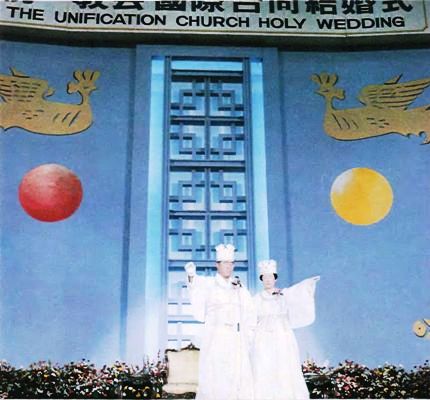![]()
The Words of the Baum Family
|
|
The Words of the Baum Family |

On the second day after the Blessing, a group of about 40 members of CARP-USA and their spouses went on a trip north of Seoul to visit the grave of Rev. Chong Goo ("Tiger") Park, the late leader of CARP in America and Europe. The Korean family provided us with a bus, and Mr. Kim, a member of Korean CARP headquarters, accompanied us. The trip became for many of us a most moving experience, both of the Korean homeland and of the hospitality and depth of service of our Korean brothers and sisters.
The burial ground was supposed to be a one-hour trip north of Seoul, but after two hours of driving through the Korean countryside, most of us knew that we must be lost. Yet few of us minded, because it allowed us to see so much more of our homeland. After leaving the hustle and bustle of Seoul, the typical picturesque countryside opened up to us. We enjoyed seeing the beautiful fields stretching from mountain to mountain. The small villages spread alongside the road seemed to have a peace that can only be found in rural areas. The mountains rose jagged and masculine, and it was so beautiful to see our real homeland.
A little later we arrived at a larger village, but once again we were lost. So Mr. Kim went on search for the local Unification Church center. Mrs. Lim, the wife of the church leader for the prefecture, hopped on the bus and led the way to the mountain where the cemetery was located and guided us up the path to the grave sites.
First we visited the grave of the late President of the Korean Unification Church, Hyo Won Eu. I sensed we were taking part in a historical event.
The Korean graves have a large earthen mound, about four or five feet high, over the actual tomb. In front of the mound is a small stone, and off to the right a stone pillar four to six feet high, with the name of the person buried there engraved on the front and a short biography of him on the back.
As we were praying at President Eu's grave site, suddenly I felt that this was truly a point of crossroads of history -- the past represented by President Eu, one of the earliest members, who had given his life to teach the truth to the world, and the future represented by the 40 brothers and sisters who had all been blessed only two days before. I felt that from now on, we owe it to the late President Eu to carry on his mission. We were the fruits of his labor, and the truth he had taught had already elevated us, allowing us to stand there as blessed couples. Now we had to go to the world to carry the message to our brothers and sisters worldwide.
The local church leader, Mr. Lim, had by now caught up with us, and he explained that he comes every day of the year, in ram and snow, to take care of the graves of all those members buried here. He shared with us that actually the whole mountainside and several adjoining valleys were the property of the Unification Church, and that he himself had planted thousands of small trees up there. He had even won several awards from the church as well as the Korean government for being the individual who has planted the largest number of trees.
When we arrived at Tiger Park's grave, we all felt disappointed, because there were no stones to mark his grave. It seemed amazing to me the extent to which Tiger Park had affected our lives, that we would spend the second day after our own wedding in pilgrimage to his grave. He had truly left his mark on history and would never be forgotten by us.
After praying at Tiger Park's grave, we sang a few fighting songs in loving memory of the "tiger" who had led us so gloriously in the fight against communism and who had charged ahead of us into battle with the enemy.